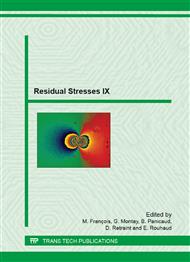p.586
p.592
p.598
p.603
p.609
p.615
p.622
p.628
p.634
Influence of Vibration and Heat Treatment on Residual Stress of a Machined 12%Cr-Steel
Abstract:
In this paper we investigated the influence of vibratory stress relieving technique, which is widely used for stress relaxation of weld and casting components/structure, on machining residual stresses in a ring-component of 12%Cr-steel. It was shown that the employed vibratory treatment, without significantly altering the microstructure, turned the surface layer from tension into compression but retained the compressive residual stresses in the subsurface. In comparison, a stress relieving heat treatment, included as a reference in the study, removed completely the surface tensile residual stresses and reduced the subsurface compressive residual stresses to a low level. Significant microstructural changes in the form of recrystallization also occurred in a thin surface layer of the machining affected zone after the heat treatment.
Info:
Periodical:
Pages:
609-614
Citation:
Online since:
August 2014
Authors:
Permissions:
Share:
Citation:


